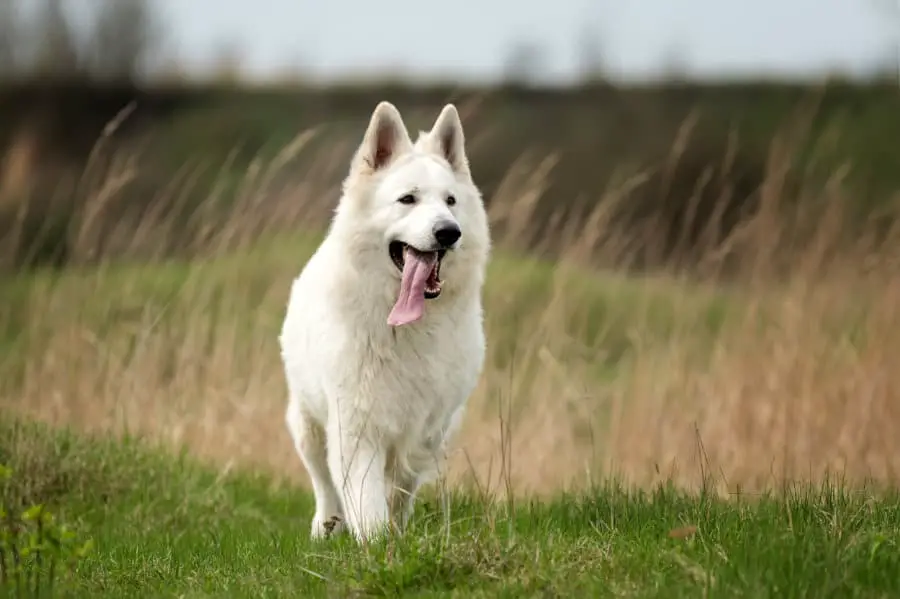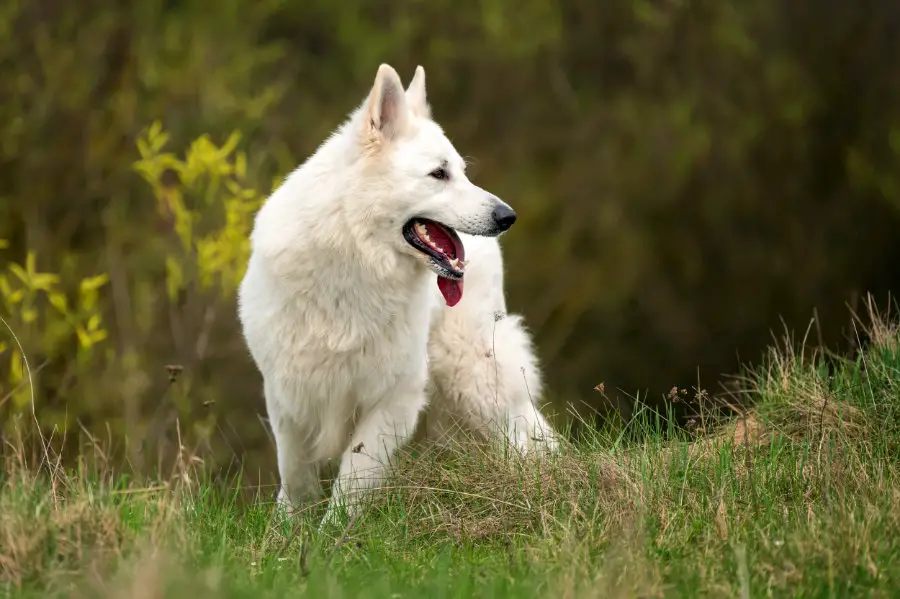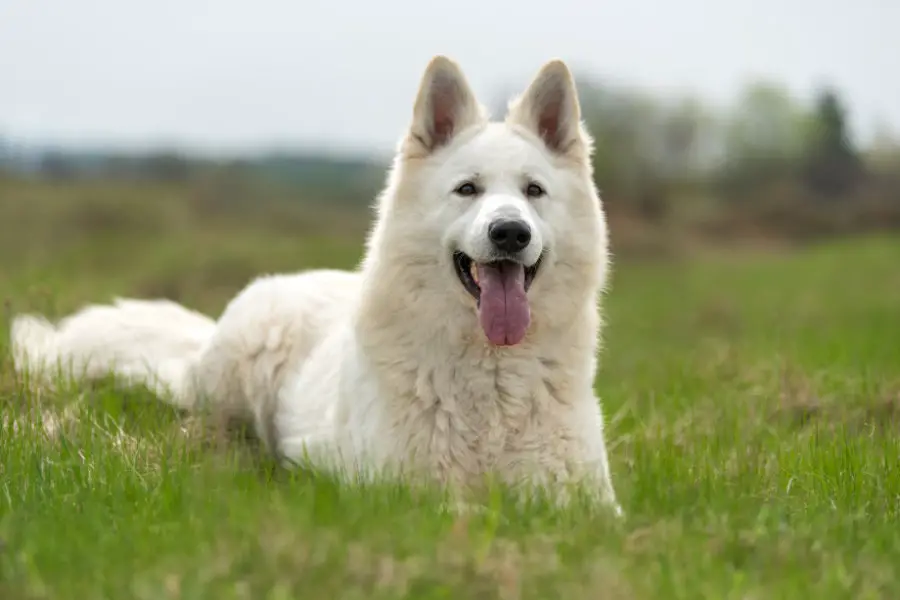German Shepherds are extremely popular dogs for families, police, and the military because of their affection, loyalty, and intelligence. But while most German Shepherds are of the colored variety, there are also a more rare type of German Shepherds that are all white in appearance.
White German Shepherds are considered undesirable because of their lack of breed recognition. White German Shepherds have the same physical appearance, minus the color, as a traditional German Shepherd, but are recognized under the White Shepherd breed by the American Kennel Club.
Let’s take a look at what causes a German Shepherd to be all white, the differences between them and their colored counterparts, frequently asked questions about the White Shepherd and the benefits of a standard colored German Shepherd over all-white GSDs.
History of the White German Shepherd
German Shepherds were first bred in Germany back in the late 1800s as herding dogs that helped local farmers to herd their sheep and protect their livestock. Their obedient and loyal temperaments made them the ideal candidates for this role. At this time, German Shepherds were not yet considered household pets and were primarily bred to work on farms.
Over the next few decades, German Shepherds became a popular choice for farmers in not only Germany but throughout other parts of the world as well. As soldiers returned to the United States from World War I, they spread the word about the beauty, loyalty, working ability, and intelligence of the German Shepherd.
During this period, colored German Shepherds were more common (similar to how they are today), but white German Shepherds have been present since the earliest days of the breed. They were even extremely popular and sought after choice due to their unique appearance. Farmers also favored the white German Shepherds’ ability to blend in with their flocks of sheep while herding because it made predators easier to distinguish.

However, the white German Shepherd’s popularity didn’t last long. By the 1930s, the white coloring of a German Shepherd was considered to be a fault. It was even believed that the recessive genes causing the dog to be white were also the same genes that would cause disease.
Because word was spreading that a white German Shepherd was an undesirable trait, these dogs were discriminated against and weren’t allowed to be bred or shown. By World War II, German Shepherd dogs had become the military breed of choice because of their loyalty and intelligence.
This lack of popularity followed the white German Shepherd all the way to the United States when the American Kennel Club banned them from the conformation ring. However, they are still able to participate in herding trials and obedience competitions and to be registered as a purebred German Shepherd.
In 1995, the American White Shepherd Association was created and with the help of the White Shepherd Club of Canada, these two groups worked together to petition that the white German Shepherd be recognized by the American Kennel Club.
What Causes the White German Shepherd?
When picturing a German Shepherd litter, you probably envision standard colored German Shepherd puppies. But that’s not always the case.
While not common, all-white German Shepherds have been present in litters since the breed’s start. What causes this all-white phenomenon? The exact reason for a puppy being born with an all-white coat is still unclear, but there are a few scenarios that can lead to an all-white German Shepherd.
A common misconception is that German Shepherds have white coats because of albinism. While the albino gene can be present, this isn’t common and most all-white German Shepherds do not carry this defective gene. The white German Shepherd is the result of a recessive coat color gene that acts as a shield, blocking the dog’s standard color and patterns from forming.
White German Shepherds can be bred when one of the following scenarios takes place:
- If a non-white German Shepherd without the white gene breeds with an all-white German Shepherd, their litter will be non-white but will carry the white gene.
- If two non-white German Shepherd carry the white gene, there is a chance that their offspring will be white.
- If two all-white German Shepherds produce offspring, their litter with always consist of all-white puppies.
While these are scenarios in which white German Shepherds are born, the reason for the recessive gene is unknown.
Standard German Shepherd vs. White German Shepherd
While the colors of a standard German Shepherd and an all-white GSD are strikingly different, there are many similar traits shared between the two.
Similar Traits:
- Both colorings of German Shepherds have pointed erect ears.
- They both have a large stature and muscular build.
- No matter which color fur, all German Shepherds shed equally.
Different Traits:
- The most notably different trait is the color of their fur.
- White German Shepherds tend to have longer length fur.
- Standard German Shepherds have a double coat while white GSDs might not.

The biggest difference between the two is that an all-white German Shepherd isn’t recognized within the breed standard. If you are an avid German Shepherd lover, an all-white German Shepherd might be undesirable to you because it won’t be classified under the desired breed. (Here’s a link to a more in-depth article about Standard vs. White German Shepherds).
Frequently Asked Questions About White German Shepherds
While there are many similarities between white and colored German Shepherds, there are also many myths and misconceptions. Let’s take a look at the most frequently asked questions about white German Shepherds.
Is The White German Shepherd Considered A Different Breed?
While they are technically the same breed, a white German Shepherd isn’t recognized as such.
The white coloring of a German Shepherd is considered a faulty trait that does not fit within the breed standards — meaning that you can’t classify your dog like a German Shepherd if he is all white.
During the 1970s, supporters of the white German Shepherd began forming their own clubs and registries, trying to get recognition for their dogs. In 1999, the second-largest dog breed registry in the United States, the United Kennel Club (UKC), formally began recognizing the white German Shepherd — but as it’s own separate breed known as the White Shepherd.
How Common Are White German Shepherds?
Because not all dogs carry the recessive white gene, white German Shepherd is much rarer than the standard variety. Over the years, white GSDs have been popular within certain dog communities. This has caused the price to rise because of their rare characteristics. While white German Shepherds have become more popular in certain crowds, the majority of dog owners looking for a German Shepherd purchase a puppy of the colored variety because breed recognition is more important to them.
When in the market for a purebred German Shepherd puppy, you’ll notice that the price will vary depending on the breeder’s reputation, location, family bloodline, and litter size. On average, most white German Shepherds will cost around $1,500 because of their exclusivity, while their colored counterparts can go for around $1,000.
Can A White German Shepherd Breed A Colored Litter?
Breeding a white German Shepherd with a colored German Shepherd will produce colored offspring with the occasional white puppy in the mix — but a white puppy might not happen at all!
This is dependent on the colored German Shepherd and if they carry the white gene. If a non-white GSD carries the recessive color gene, the offspring has a 50% chance of being colored or white. If a non-white GSD does not carry the recessive color gene, all of the puppies will be on a colored variety.
Because breeders can’t determine if a non-white German Shepherd carries the white gene or not, it is difficult for them to determine what colors the pups will be before breeding them.
However, two all-white German Shepherds can’t produce a colored litter — all the puppies with be white and carry the recessive gene.
Do White GSDs Have a Different Temperament Than colored GSDs?
Both dogs, no matter the color of their fur, share similar temperaments. But it is a common belief that all-white German Shepherds are less aggressive or calmer than standard colored GSDs.
Whether you take home a white or colored puppy, you can expect your German Shepherd to be very smart, loyal, loving, and protective. All GSDs are known for forming an extremely close bond with their owners, doing whatever they can to protect them. This is why you will commonly see German Shepherd used in the police and military and therapy dogs. However, white German Shepherds are often not used in these instances, with colored GSDs being preferred.
If you don’t have an active lifestyle, a white German Shepherd isn’t for you. These dogs are high energy and need to have both physical and mental exercise. This can be done through regular walks or runs or obedience and trick training.

Like colored German Shepherds, an all-white dog loves having a job to do and listening to their owners’ commands — making them excellent at picking up new tricks or commands when training. While they are easy to train, they can be very anxious or cautious around new people, making it hard to take them in public places or having visitors to your home. It’s important to include proper socialization into your training routine to avoid having an aggressive German Shepherd.
Overall, a white German Shepherd will be the same smart, loyal, and affectionate dog as a colored German Shepherd. If you’re looking for a dog that will fit right in with your family, protect you and your children, and be a great companion for long walks or runs, then a German Shepherd might be the right dog for you.
Do White German Shepherds Experience Any Health Issues?
Like most medium- to large-sized dogs, all-white German Shepherds are more susceptible to health issues like hip and elbow dysplasia. However, this doesn’t usually become apparent until later on in the white GSDs’ life.
While hip and elbow dysplasia are the most common health concerns for a German Shepherd, you should keep an eye out for:
- Skin problems
- Heart disease
- Diabetes
- Cataracts
- Thyroid issues
- Cancer
- Urinary tract infections
- Epilepsy
Whether you have a colored or white German Shepherd, ensure you’re taking your dog to the vet for regular checkups. Seeing a veterinarian regularly will help you catch any issues early on and treat them before becoming an uncomfortable problem for your German Shepherd. You can learn more about their health concerns in this article: “The Common Health Issues With White German Shepherds”.
Do White Shepherds Shed Like Their Colored Counterparts?
White German Shepherds, like colored GSDs, shed a lot. Although their hair looks different, it is a similar consistency and texture of colored fur. Their double coat means that they have a dense, outer layer that can easily shed. The underlayer is thick, short hair that blows out twice a year, especially during hot times of the year.
White German Shepherds are known to shed slightly less than colored German Shepherds because they have a thinner undercoat. This isn’t always the case, but a definite factor to consider when looking at getting a German Shepherd.
Regularly brushing and bathing your German Shepherd can help to limit the amount of unwanted hair that you will find around your home, on the floors, and stuck to your clothes and furniture. However, you don’t want to bathe them too often or you can remove natural oils from their skin that help them to maintain a healthy coat.
Can White German Shepherds Compete?
In 1968, the German Shepherd Dog Club of America listed the color white as a disqualifying fault, which disqualifies the white German Shepherd from the American Kennel Club’s conformation ring.
There are specific organizations, like the Canadian Kennel Club, that allow white German Shepherds to be shown in the breed ring. However, their white appearance is considered a less desirable trait.
Is A White German Shepherd Considered To Be Albino?
While there are albino German Shepherds, a white GSD has a white recessive gene and is not considered albino. While an albino dog would be void of any pigment, white German Shepherds still have pigment in their eyes, lips, skin, mouth, nose, paw pads, and more.
They resemble a typical German Shepherd in every way — only with white fur! Because of these colored elements on the GSD, they are not considered albino.
Do White German Shepherds Have Hearing Or Sight Problems?
It is thought that the cells that create the pigmentation of hair and skin play an important role in how your dog’s inner ear works. This is why when you’ve seen other all-white dogs that are double-merle or piebald, they are usually all white, often are deaf, deal with vision loss or blindness, or in more severe cases, are both blind and deaf.
While white German Shepherds have the white coat, they become this color because of a recessive color gene — they aren’t considered albino, merle, or piebald. Because of this, they have the white-colored fur but don’t deal with the same sight or hearing issues that these other abnormally all-white dogs do.
Reasons To Choose A Colored German Shepherd Over An All-White GSD
If you’re considering adding a German Shepherd to your family, there are many reasons why a colored GSD is a more desirable choice:
- Breed Recognition – If breed recognition is important to you, you should stick with a colored German Shepherd. Because of an all-white German Shepherd coloring, the American Kennel Club (AKC) and the United Kennel Club (UKC) does not recognize these dogs as part of the German Shepherd breed and classify them as a White Shepherd. This decision’s main reasoning is that they would not be adequate sheep herding dogs, which is their primary breeding purpose, because of their furs resemblance to the white color or sheep.
- Cleanliness – If you have an extremely active lifestyle, you might want to think twice before getting an all-white German Shepherd. Whether you plan to take your dog to the beach or on weekend hikes, all dirt will be extremely visible on their white fur. This means you will have more grooming sessions in your future.
- Lineage Defects – Abnormally white dogs, no matter the breed, are often views as a defect in most breeds. This can ruin a breeder’s reputation if they are unintentionally breeding white puppies because many people often believe that white dogs will have hearing or vision problems or will be hyperactive.
- Shedding – All German Shepherds, no matter the color, are big shedders so expect to have lots of fur all over your home and clothes. However, when you have an all-white German Shepherd, their fur will be more apparent because of it’s light color — making it much more difficult to blend into your home, resulting in more frequent vacuuming.
Whether you choose a colored or white German Shepherd, you’ll have a loyal and loving dog that will quickly become part of your family. The White German Shepherd has gotten a bad rap over the years, but there is little stopping them from being your next best friend.
